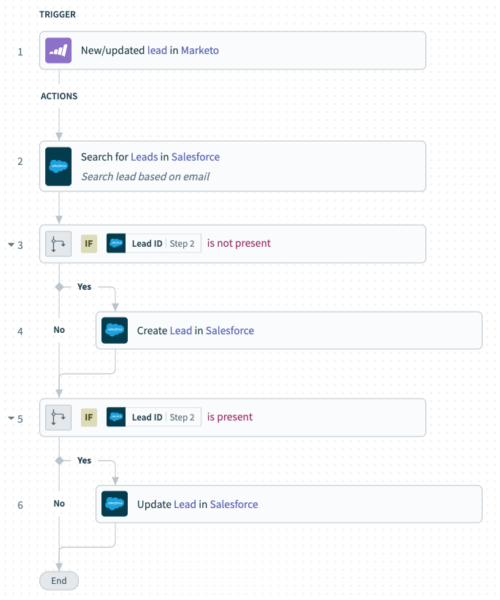As organizations look to integrate their applications and databases, they’ll often decide between using one of two methods: integrating at the user-interface level (i.e. using robotic process automation software) or through available application programming interfaces (APIs).
There isn’t always one “right answer”. For example, in many cases, the best approach depends on the systems you’re connecting or the type of data you’re either moving or keeping in sync.
To help you suss out the approach that makes the most sense for your integration scenarios, we’ll review API integration and robotic process automation (RPA) individually and then compare them directly.

Implement UI and API-based integrations with Workato
Workato, the leader in enterprise automation, lets you implement integrations that use both APIs and screen scraping, all but ensuring that you’re able to get the most out of each approach.
What is API integration?
It’s the use of a 3rd-party platform or an in-house solution to connect applications or databases via their application programming interfaces.
Here’s how API integration can work when you leverage a CRM’s and marketing automation platform’s connectors via a 3rd-party API integration platform:

1. Once a lead score gets updated in a marketing automation platform like Marketo, the workflow gets triggered.
2. If the lead doesn’t exist in a CRM like Salesforce, it gets created; if the lead already exists, the workflow skips to the next step.
3. The lead score field for the associated account in your CRM gets updated according to the change in Marketo.
Related: Popular examples of API integration
Pros and cons of API integration
Here are some of the pros and cons of API integration:
Pros
- Can move data in near real-time (i.e. within milliseconds)
- Isn’t affected by changes in an application’s UI
- Offers a security layer with access controls to ensure that only predefined personnel have access to specific data points
- Enables powerful automation use cases
Cons
- Legacy systems often don’t offer APIs
- Building to APIs in-house can be resource and time-intensive for your developers
- API calls can potentially be costly over time
Related: 6 benefits of API integration
What is RPA?
It’s a type of software that uses software scripts, or “bots”, to copy human tasks at the UI-level. The software can be delivered in the cloud or on-premises, and, depending on the vendor, it can come with additional functionality, such as intelligent document processing.
Here’ a common use case for RPA software:

1. An RPA bot copies fields from a specific spreadsheet.
2. It creates a new lead record in your CRM.
3. It pastes the copied data into the corresponding fields in the new lead record.
Pros and cons of RPA
Let’s take a look at its benefits and drawbacks:
Pros
- Given its ability to perform “screen scraping”, RPA can work with a wide spectrum of systems and perform countless tasks
- Can work effectively when tasks and applications’ UIs change infrequently
Cons
- Isn’t built to handle complex workflows
- Can easily break when an application’s UI changes
- Often difficult to scale, as automating more tasks with RPA requires implementing and maintaining more bots—both of which requires a high level of technical expertise
Related: iPaaS vs PaaS
RPA vs API integration
RPA software can work well when you only need to automate a specific set of tasks that change infrequently and when the integrated applications’ UIs rarely change. Otherwise, APIs are likely to do a better job of meeting your integration requirements.

Implement UI and API-based integrations with Workato
Workato, the leader in enterprise automation, lets you implement integrations that use both APIs and screen scraping, all but ensuring that you’re able to get the most out of each approach.
